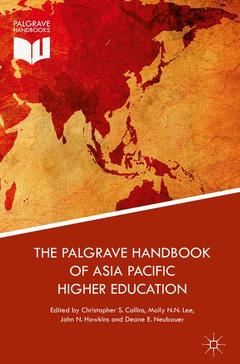Part A: Asian Higher Education in the Era of Contemporary Globalization.- Introduction—Collins, Hawkins, Lee, Neubauer.- Chapter 1: John N. Hawkins, “Education in the Asia/Pacific Region: Historical Context”.- Chapter 2: Sheng Ju Chan “A Journey Back to the Center: Asian Higher Education in Global Context”.- Chapter 3: Anthony Welch, “Asian Higher Education: Achievements, Challenges, Prospects”.- Chapter 4: Deane E. Neubauer and John N. Hawkins, “Prospects for Higher Education in the Midst of Globalization”.- Chapter 5: Christopher Ziguras, “Globalization and the Transformation of Asian Higher Education”.- Chapter 6: Christopher Collins, “Public Good in Asian Higher Education”.- Chapter 7: Molly N. N. Lee, “Strategies for Higher Education in the Contemporary Era: Public-Private Partnerships and Regional Cooperation”.- Part B: The Forces of Regionality in Asian higher education—Introduction Christopher S. Collins, John N. Hawkins, Molly N.N. Lee, Deane E. Neubauer.- Chapter 8: Jane Knight, “Regionalization of Higher Education in Asia Functional, Organization, and Political Approaches (FOPA)”.- Chapter 9: Molly N. N. Lee, “Regional Trends in Asian Higher Education”.- Chapter 10: Kazuo Kuroda, “Regionalization of higher education in Asia”.- Chapter 11: Michael Lanford and William G. Tierney “The International Branch Campus: Cloistered Community or Agent of Social Change?”.- Chapter 12: Hu Die Wen Wen, “China’s approach towards HE regional cooperation with ASEAN”.- Chapter 13: Miki Sugimura, “Transformation of Higher Education Systems in the Dynamics of Contemporary Globalization: The Case of Japan.”.- Chapter 14: Edilberto C. de Jesus, “Cross Currents in Asian Higher Education”.- Chapter 15: Jinghuan Shi, Lyeong Jo, and Jiayi Li, “Prospects for Higher Education in the Asian Region with Specific Reference to China.”.- Chapter 16: Rui Yang, “Cultural Challenges Facing East Asian Higher Education: A Preliminary Assessment”.- Chapter 17: Akiyoshi Yonezawa “Can East Asian Universities Break the Spell of Hierarchy? The Challenge of Seeking an Inherent Identity”.- Chapter 18: Molly N.N. Lee, “Reforms of University Governance and Management in Asia: Effects on Campus Culture”.- Chapter 19: Christopher S. Collins, Athena Castro, and Tasha Kawamata Ryan, “The Driving Forces of Higher Education: Westernization, Confucianism, Economization, and Globalization” Part C: Access, equity, capacity and quality in the overall context of the massification of Asia Higher Education—Introduction Christopher S. Collins, John N. Hawkins, Molly N.N. Lee, Deane E. Neubauer.- Chapter 20: Prompilai Buasuwan and Wanwisa Suebnusorn, “Higher Education Inequality in East and South-East Asia”.- Chapter 21: Yuchen Yang, “Higher Education in China: Massification, Accessibility, and Quality Issues”.- Chapter 22: Peter D. Hershock, “Equity and Higher Education in the Asia Pacific”.- Chapter 23: W. James Jacob and Weiyang Xiong, “Higher Education Capacity for What? Balancing Issues of Equity, Efficiency, Choice, and Excellence”.- Chapter 24: Yuto Kitamura: “Higher Education in Cambodia: Challenges to Promote Greater Access and Higher Quality.”.- Chapter 25: Angela Hou, “Quality Assurance in Asian Higher Education: Challenges and Prospects”.- Chapter 26: Ralph Wolff, Current Issues With Accreditation in the United States.- Chapter 27: Reiko Yamada, “Impact of Globalization on Japanese Higher Education Policy: Examining Government Control and Quality Assurance”.- Chapter 28: Ka Ho Mok and Sheng-Ju Chan, “After Massification and Response to Internationalization: Quality Assurance of Higher Education in Taiwan and Hong Kong”.- Chapter 29: Sheng Yao Cheng and Ming-li Yao “The Paradigm Shift on Quality Assurance of Higher Education in Taiwan”.- Part D: Country Cases—Introduction: Christopher S. Collins, John N. Hawkins, Molly N.N. Lee, Deane E. Neubauer.- Chapter 30 : Ma Wanhua, “Massification of Chinese Higher Education: Policies and Practices”.- Chapter 31: Morshidi Siratand Chang Da Wan “Higher Education in Malaysia”.- Chapter 32: Serafin L. Ngohayon and Julian B. Nangpuhan II, “Pushing For Globalized Higher Education in the Philippines: Advances and Challenges”.- Chapter 33: Yuan Xun, “Situating Higher Education in China: From Universal History to the Research Paradigm”.- Chapter 34: Ekaphon Lauhathiansind and Nongnuch Chunbandhit, “Thai Higher Education”.- Chapter 35: Shyam Menon, “Higher Education in India: Against the Backdrop of the Evolving Political Economy”.- Chapter 36: Jason Tan, “Singapore: A Small Nation With Big Dreams of Being a Global Schoolhouse”.- Chapter 37: Chiara Logli, “Higher Education in Indonesia: Contemporary Challenges in Governance Access and Quality”.- Chapter 38: Sarah French and Richard James, “Australian Higher Education”.- Chapter 39: Francis L. Collins and Nick Lewis, “New Zealand Universities: The Prospects and Pitfalls of Globalizing Higher Education”.- Chapter 40: Peter Tan Keo and Alexander Jun, “Higher EducationalInstitutions and ASEAN: Current Trends and Implications for Innovation and Change”.- Chapter 41: Menho Yeom, “The Rapid Growth of Higher Education in South Korea: Achievements, Dilemmas, and Resolutions”.- Chapter 42 : Phuong-Lan Bui “Vietnam: The Demand for Change and the Direction Taken”.- Chapter 43: Lyudmila Kovalea and Jack T. Lee, “Higher Education in Kazakhstan”.





